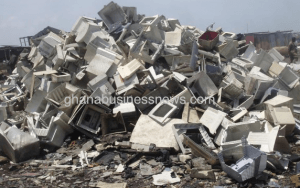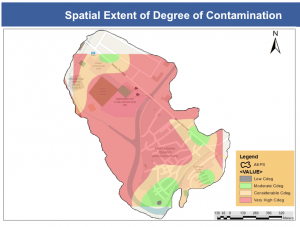Multiple studies show Ghana e-waste contamination is spreading

The environmental and health risks posed by the cancer causing agents in electronics waste or e-waste are getting closer to many Ghanaians living in and around the e-waste processing centre in Agbogbloshie in Accra.
Multiple scientific studies done on soil and water collected from the sites are showing extremely higher levels of carcinogenic substances such as lead, cadmium, barium and others, and these are spreading beyond the processing site. The contamination has reached areas including James Town, Korle-Gonno and the Korle-Bu Teaching Hospital.
The environmental group, Greenpeace in 2008 conducted the first scientific test of the soil and water at Agbogbloshie. Results of lab tests of the soil and water, showed that the soil and water in the area contained toxic chemicals at levels a 100 times more than World Health Organisation allowable limits.
According to some medical sources at the Korle-bu Teaching Hospital, some of the chemicals found in e-waste are potential cancer causing agents, adding that, however, it takes time for the disease to show in an individual who has come into contact with the chemicals. When people come into contact with these chemicals, they get into the blood system through touch, inhalation and ingestion.
At a recent workshop on e-waste organised on the sidelines of the West African Clean Energy & Environment Exhibition & Conference in Accra some graduate students presented their works on the subject.One of them was Vincent Kyere Nartey.
Vincent Kyere Nartey’s PhD work titled ‘Spatial impacts of informal e-waste recycling site in Agbogbloshie, Ghana’ found that not only is the contamination extremely high, it is also spreading wide beyond the processing centre.
Confirming what has always been known and suspected; Nartey found that e-waste comes into Ghana through both legal and illegal means concealed as ‘second-hand items’. He also found that about 41.8 million tons of e-waste were discarded worldwide, with the US, China and Europe being the highest generators.

The study done in collaboration with the government of Nordrhein-Westfalen Germany and the Centre for Development Research, University of Bonn focused on the 6.2 hectares of land space made up of a number of clusters. These are dismantling, burning areas, health centers, food markets and commercial areas in Agbogbloshie.
It looked at heavy metal contamination, ecological and human health risks and loss of rare earth metals. The study collected 132 soil samples from the area and tested for barium, lead, copper and zinc. When the samples were tested they were found to contain exceedingly higher levels of the poisonous chemicals most of which are also known to be carcinogenic. According to Nartey, the heavy metals in the soils exceeded both the Dutch and Canadian Soil Quality and Guidance Values by 10 to 1000 times, thereby posing potential risks to human and ecological health.
Meanwhile, a report released August 30, 2015 by the United Nations and INTERPOL says only a third of Europe’s electronic waste is properly recycled, with vast numbers of cellphones, computers and televisions illegally traded or dumped.
The 56-page report titled, “Countering Waste Electrical and Electronic Equipment Illegal Trade” states that Sweden and Norway were close to European targets of collecting and recycling 85 per cent of all electrical and electronic waste, at the top of a ranking in which Romania, Spain and Cyprus were bottom with less than 20 per cent.
The 35 per cent, the report indicates, amounts to 3.3 million tons of 9.5 million tons of used but still functioning and waste electronics and electrical equipment discarded by companies and consumers in 2012 wound up in official collection and recycling systems.
The other discarded electronics, according to the report, some 6.2 million tons in all – was either exported, recycled under non-compliant conditions or simply thrown in waste bins.
The study estimates that 1.3 million tons of discarded electronics departed the EU in undocumented mixed exports, of which an estimated 30 per cent, that is about 400,000 tons was electronic waste; and 70 per cent functioning equipment.
An article in the Seattle Journal of Environmental Law, published May 31, 2015, claims that 10 to 13,000 metric tons of e-waste is processed in Accra annually and these contribute about $105 million to $268 million into Ghana’s economy.
The article points out that e-waste also sustains between 121,800 and 201,600 people in Ghana, from the 250,000 metric tons that enters Benin, Côte d’Ivoire, Ghana, Liberia, and Nigeria annually despite the presence of efficient recycling facilities in Europe, and state laws requiring otherwise.
From initial denial of the existence of e-waste in Ghana, state institutions like the Environmental Protection Agency (EPA) has come to acknowledge the problem. In 2011 with the support of a Swiss organization EMPA, the EPA worked with other groups to conduct a comprehensive assessment report of the e-waste situation in Ghana.
The study found that 171,000 tons of e-waste reach the country’s informal recycling sector, adding that the amount of material that reaches the formal recycling sector accounted only for 0.2%.
By 2012, an E-Waste Bill for Ghana was drafted. The Bill is yet to be put before Parliament.
By Emmanuel K. Dogbevi
